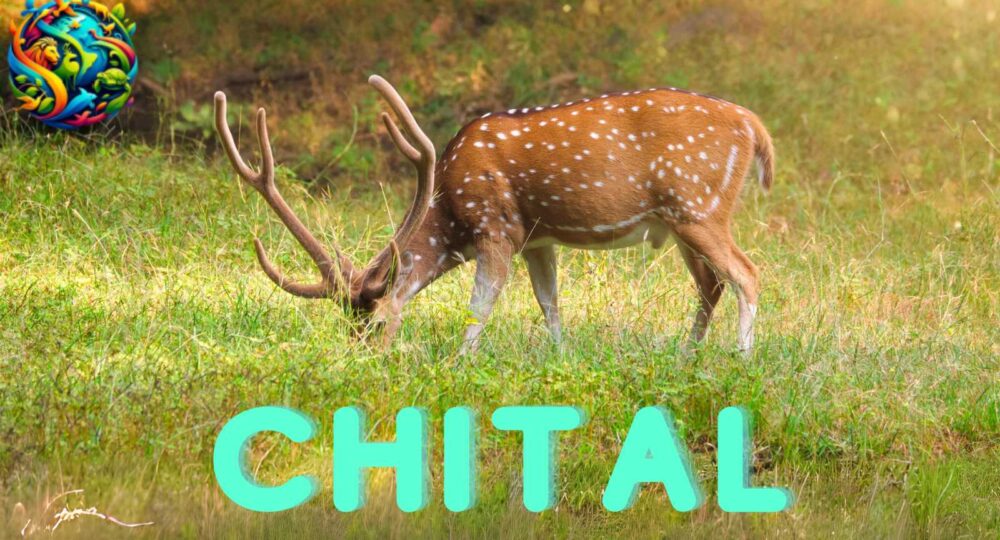
Chital: Graceful Inhabitants of Indian Forests
Chital: Graceful Inhabitants of Indian Forests
Introduction
The chital, also known as the spotted deer or axis deer, is a captivating species native to the Indian subcontinent. Renowned for their striking appearance and graceful movements, these deer are a common sight in forests and grasslands of India, Sri Lanka, Nepal, Bangladesh, and Bhutan. The chital plays a significant role in its ecosystem and holds cultural and religious importance in various societies. This article explores the fascinating world of chital, covering their habitats, physical characteristics, behaviors, and much more.
Amazing Facts
Chital possess numerous intriguing attributes:
- Striking Appearance: Known for their reddish-brown coat adorned with white spots, giving them a distinctive and attractive appearance.
- Vocal Communication: They use a range of vocalizations, including alarm calls that sound like barks, to alert others of predators.
- Social Structure: These deer live in herds that can consist of up to 100 individuals, typically led by a dominant male.
- Speed and Agility: Chital are agile runners and excellent swimmers, helping them evade predators.
- Longevity: In the wild, they can live up to 10 to 12 years, while in captivity, they may live slightly longer.
Habitat and Food
These adaptable creatures thrive in various environments, reflecting their versatility and resilience.
Habitat:
- Found primarily in the forests and grasslands of the Indian subcontinent, including India, Sri Lanka, Nepal, Bangladesh, and Bhutan.
- They prefer areas with dense forest cover and nearby water sources, such as rivers and lakes.
- These deer are often found in deciduous forests, tropical dry forests, and open grasslands.
Food:
- Herbivorous, with a diet consisting of grasses, leaves, fruits, and tender shoots.
- During the dry season, they may browse on shrubs and fallen leaves.
- They are known to occasionally consume cultivated crops, leading to conflicts with farmers.
Appearance
Chital are known for their striking and graceful appearance. Key characteristics include:
- Size: Adults stand about 2.5 to 3.5 feet (75 to 100 cm) tall at the shoulder and weigh between 90 to 170 pounds (40 to 75 kg).
- Color: Their coat is reddish-brown with white spots scattered across the back and sides. They have a white underbelly and a dark stripe running along the back.
- Antlers: Males (bucks) grow large, three-pronged antlers that can reach up to 3 feet (90 cm) in length. These antlers are shed and regrown annually.
- Build: They have slender, agile bodies with long legs, adapted for running and jumping.
- Ears and Eyes: Their large, expressive eyes and ears provide keen senses of sight and hearing.
Types/Subspecies of Chital
While chital are generally considered a single species (Axis axis), they may exhibit regional variations in size, coat color, and antler shape, but no formally recognized subspecies exist.
Predators and Threats
Despite their agility and adaptability, chital face various natural and human-induced threats that impact their survival.
Natural Predators:
- Tigers: Tigers are the primary predators, using stealth and power to hunt these deer.
- Leopards: Leopards also prey on them, particularly targeting younger or smaller individuals.
- Wild Dogs: Packs of dholes (wild dogs) can pose a significant threat, using teamwork to hunt.
- Crocodiles: In areas near water bodies, crocodiles may prey on these deer, especially when they come to drink.
Threats:
- Habitat Loss: Urban development, agriculture, and deforestation reduce available habitats.
- Human-Wildlife Conflict: They often come into conflict with humans when they raid crops or are involved in vehicle collisions.
- Poaching: Illegal hunting for their meat, antlers, and hides can threaten specific populations.
- Climate Change: Alterations in weather patterns and habitat conditions due to climate change can impact food availability and migration patterns.
Mating
Chital exhibit unique and complex mating behaviors, essential for the continuation of their species.
- Breeding Season: The rut typically occurs throughout the year, with peaks during the monsoon season.
- Courtship Displays: Males engage in courtship behaviors such as vocalizations, antler displays, and physical sparring to attract females.
- Territoriality: During the rut, males become highly territorial and will fight rivals to maintain dominance and access to females.
- Gestation and Birth: After a gestation period of about 7.5 months, females give birth to one or two fawns. Fawns are hidden in dense vegetation for protection and are weaned by the age of 6 months.
How They Communicate
Chital use various methods to communicate with each other, particularly during mating and social interactions.
Vocalizations:
- Alarm Calls: They emit loud, bark-like alarm calls to alert others of predators.
- Grunts and Squeals: Used to communicate with each other within the herd, particularly between mothers and fawns.
Body Language:
- Posturing: Males use body postures, such as raised hackles, tail positioning, and ear movements, to convey aggression, submission, or readiness to mate.
- Antler Displays: Males use antler displays and sparring to establish dominance and attract mates.
Chemical Signals:
- Scent Marking: They use scent glands located on their legs, forehead, and hooves to mark territory and signal reproductive status.
Religious and Cultural Significance
Chital hold significant symbolic and cultural importance in various societies:
Indian Culture:
- Spiritual Symbol: In Hinduism, chital are associated with deities and are considered symbols of grace, beauty, and fertility.
- Conservation Symbol: They are often used in conservation campaigns to raise awareness about wildlife protection and the importance of preserving natural habitats.
Modern Symbolism:
- Popular Culture: These animals appear in various forms of media, from literature and art to movies and advertising, symbolizing the grace and beauty of the Indian wilderness.
Movies Featuring These Graceful Creatures
Chital have been featured in various films and documentaries, showcasing their behaviors and the challenges they face:
- “The Jungle Book” (1967): An animated classic that features a variety of Indian wildlife, including chital, highlighting the rich biodiversity of Indian forests.
- “Planet Earth II” (2016): The “Grasslands” episode includes stunning footage of these deer in their natural habitat, showcasing their interactions with other wildlife.
- “Wild India” (2012): A documentary that explores the diverse wildlife of India, featuring segments on these deer and their survival strategies.
Pronunciation in Different Languages
The term for these graceful creatures is pronounced differently across various languages, reflecting linguistic diversity:
- English: /ˈtʃiːtəl/
- Spanish: /ciervo moteado/
- French: /cerf tacheté/
- German: /Axishirsch/
- Italian: /cervo maculato/
- Mandarin Chinese: /斑鹿 (bān lù)/
- Japanese: /チタル (chitaru)/
- Russian: /пятнистый олень (pyatnistyy olen’)/
- Arabic: /الأيل المرقط (al-ʾayl al-murqqat)/
- Hindi: /चितल (chital)/
FAQs
Q: What do chital eat? A: Chital are herbivores, with a diet that includes grasses, leaves, fruits, and tender shoots. During the dry season, they may browse on shrubs and fallen leaves.
Q: Where do chital live? A: Chital inhabit the forests and grasslands of the Indian subcontinent, including India, Sri Lanka, Nepal, Bangladesh, and Bhutan. They prefer areas with dense forest cover and nearby water sources.
Q: How do chital communicate? A: Chital communicate through vocalizations such as alarm calls, grunts, and squeals, body language including posturing and antler displays, and chemical signals like scent marking.
Q: Are chital endangered? A: While many populations are stable, some face threats from habitat loss, human-wildlife conflict, poaching, and climate change. Conservation efforts are essential to protect vulnerable populations.
Q: What is unique about their reproduction? A: Chital typically have a breeding season throughout the year, with peaks during the monsoon season. Males engage in courtship displays and territorial battles, and females give birth to one or two fawns after a gestation period of about 7.5 months.
The chital symbolizes the grace and beauty of the Indian wilderness, playing a vital role in its ecosystem and human culture. This exploration highlights their unique traits and behaviors, celebrating the complexity and charm of these remarkable animals







